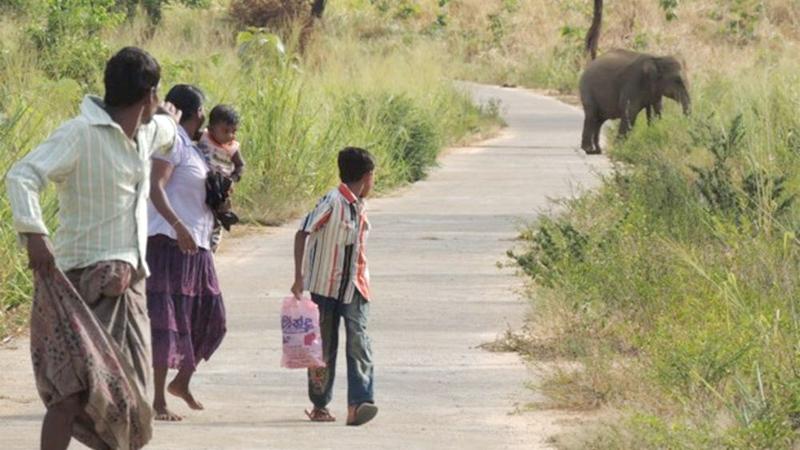
Post Covid-19 era gives the Government an opportunity to engage in sustainable development and introduce multi-cultural agriculture to ensure food sovereignty, and at the same time minimise the human-elephant conflict, environmentalist from the Movement for Land and Agricultural Reform, Sajeewa Chamikara said.
 The authorities attempted to resolve the human-elephant conflict in multiple ways, but it has shown no signs of decreasing.
The authorities attempted to resolve the human-elephant conflict in multiple ways, but it has shown no signs of decreasing.
Dead tusker
This week a tusker was found dead near the Inginimitiya Dam in Puttalam. According to wildlife officers the giant animal, believed to be 40 years old, had died after a bullet penetrated its brain.
Last year, the then government distributed 2,000 shotguns to farmers residing in Human–Elephant Conflict (HEC) zones to protect themselves and their farmlands from elephants.
Last year, 361 elephant deaths were recorded. Many were killed by people. Electric fences, poison and explosives concealed in food were directly used by farmers to kill elephants in the hope of protecting their crops. The conflict also killed over 100 people during the same period. In 2018, 319 elephants and almost 100 people were killed.
In another turn of events, officers of the Wildlife Unit in Kataragama and the Police Special Task Force arrested, during end June, a person attached to the Kataragama Devalaya for having two elephant tusks in his possession. The man also had forged documents for the elephant tusks
 The Sunday Observer reported last October that most of the elephant deaths occurred in the area designated as an ‘Elephant Corridor’ in the Elephant Management Plan of the Department of Wildlife Conservation (DWC), which ranges from Kalawewa to Habarana in North Central Sri Lanka.
The Sunday Observer reported last October that most of the elephant deaths occurred in the area designated as an ‘Elephant Corridor’ in the Elephant Management Plan of the Department of Wildlife Conservation (DWC), which ranges from Kalawewa to Habarana in North Central Sri Lanka.
National Policy
The National Policy on the Conservation and Management of Wild Elephants in Sri Lanka states, that the main strategy to minimise human-elephant conflict successfully, is the community based electric fence and permanent rural electric fences and temporary agriculture fences are the basics.
The policy also states that there should be a continuous and explicit way of benefits flowing to the people through the conservation of elephants, to convince them that the elephant is an asset. For this, it suggests to promote tourist facilities on elephant watching.
There is an estimated 7,500 elephants in the wild, but Chamikara said the population could be as low as 4500. The National Policy states that information on wild elephants should be updated.
“The human-elephant conflict is due to three main reasons. One is habitat degradation,” Chamikara said.
Habitat degradation is a result of various development projects and mass scale or commercial agriculture that result in deforestation.
The second reason that aggravates the conflict between man and jumbos is habitat fragmentation that force elephants to live in isolated pockets of forest, and the third is the reduction of the habitat quality that result in wild animals encroaching into villages to look for food.
“The invasive plants that we see spreading in national parks are another issue. They don’t allow the plants that elephants feed on to grow.
Then the elephant is left with no choice but to go to surrounding areas looking for food,” Chamikara said adding, “We have also to link the protected area so that elephants have a passage to move without coming into contact with people.”
Sustainable development
He said that sustainable development is the way forward from Covid-19 that the country should aspire to.
“We have to engage in multicultural agriculture that is small and medium scale. This will have direct effects in minimising the human-elephant conflict and at the same time will ensure food sovereignty,” he said.
****
‘The most studied elephant in the world’, euthanised
‘Shanthi,’ a jumbo that was gifted to the United States from Sri Lanka was euthanised at the age of 45. The female elephant was suffering from advanced osteoarthritis, foreign media stated.

 Her death was announced by the Smithsonian’s National Zoo and Conservation Biology Institute in the United States.
Her death was announced by the Smithsonian’s National Zoo and Conservation Biology Institute in the United States.
“After decades of managing and treating Shanthi’s osteoarthritis, animal care staff recently noted that her physical condition had declined irreversibly. They elected to humanely euthanise her on June 26. Shanthi was estimated to be around 45 years old,” the Smithsonian’s National Zoo stated.
“Female Asian elephants in human care typically live into their mid-40s; scientists speculate. Wild Asian elephants have a similar lifespan. During Shanthi’s 44-year-long tenure at the Zoo, she made significant contributions to the conservation community’s knowledge about the biology, reproduction, diseases and ecology of this critically endangered species.”
“Generations of staff and visitors have come to know and love Shanthi and, by extension, Asian elephants,” said the Zoo’s director Steven Monfort said in a statement. “Her contributions to research and medicine have made an indelible mark on our efforts to save her wild counterparts from extinction, as well as improve the lives of her fellow animal ambassadors.
Over the past few years in particular, our elephant and veterinary teams have gone the extra mile to ensure Shanthi’s physical, social and mental well-being. They have her best interest at heart, and I am grateful for their professionalism in providing her with extraordinary care and compassion.”
Shanthi is considered to be the most studied elephant in the world.
